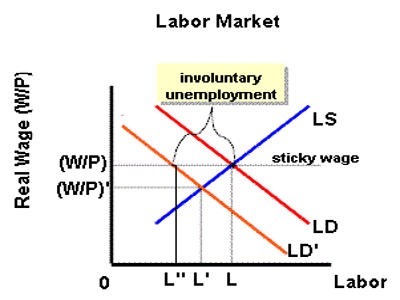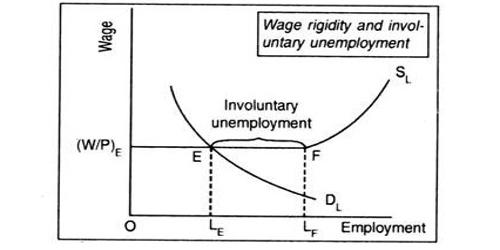Involuntary unemployment is a situation where workers are willing to work at the market wage or just below but are prevented by factors beyond their control. It occurs when a person is willing to work at the prevailing wage yet is unemployed. It means a situation in which all able persons who are willing to work at the prevailing wage rate do not get work. This type of unemployment is due to a deficiency of aggregate demand sufficient to ensure full employment.
Involuntary unemployment is distinguished from voluntary unemployment, where workers choose not to work because their reservation wage is higher than the prevailing wage. These factors could include deficiency of aggregate demand, labor market inflexibilities, implicit wage bargaining, and efficiency wage theory. Such people are (i) physically and mentally fit to work and are also (ii) willing to work at the going rate but are out of Job.
In an economy with involuntary unemployment, there is a surplus of labor at the current real wage. This occurs when there is some force that prevents the real wage rate from decreasing to the real wage rate that would equilibrate supply and demand. Structural unemployment is also involuntary. It indicates an excess supply of labor that the rigid wage-rate has failed to eliminate.

Fig: Real wage and Labor market relationship in Involuntary Unemployment
In Keynesian theory, involuntary unemployment is associated with insufficient aggregate demand and so is closely related to demand deficient unemployment. Economists have several theories explaining the possibility of involuntary unemployment including implicit contract theory, disequilibrium theory, staggered wage setting, and efficiency wages. The officially measured unemployment rate is the ratio of involuntary unemployment to the sum of involuntary unemployment and employment.
Reasons for involuntary unemployment –
- Implicit contract theory: Theoretically, unemployed workers may be willing to accept a job for a lower wage rate than the market wage. However, in practice, there are difficulties in actually offering a lower wage.
- Trade unions. If trade unions successfully bargain for wages above the equilibrium, then that ‘ outside’ the trade union is prevented from accepting a job at a lower wage rate.
- Efficiency wage theory. This theory states that firms pay workers above the market-clearing wage rate because it improves the productivity of workers.
- Shapiro–Stiglitz efficiency wage model. This model argues that at full employment, a sacked worker finds it very easy to find new employment and this encourages ‘shirking’.
- Involuntary unemployment and deficient demand. In the Keynesian model, one reason for involuntary unemployment is deficient aggregate demand.
















